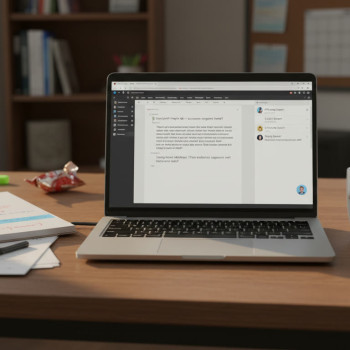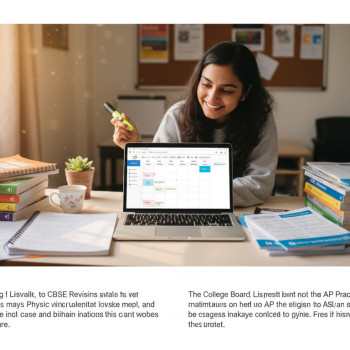Why Recovery Matters: More Than Just Rest
You finish a twelve-hour grind—notes scattered, flashcards everywhere, a half-eaten energy bar beside your laptop—and you feel both accomplished and oddly wiped out. That exhaustion isn’t a badge of honor; it’s a signal. Recovery after long study days is the secret multiplier of retention, creativity, and long-term stamina. Treating recovery like a plan (not an afterthought) turns burnt-out evenings into deliberate, restorative practices that help you remember more, stress less, and perform better on AP exams.

Principles of an Effective Recovery Protocol
Before we get to specific steps, keep three guiding principles in mind:
- Intentionality: Recovery activities work best when you choose them on purpose, not by accident.
- Variety: Mental, physical, social, and nutritional recovery all matter—mix them.
- Consistency: Small habits repeated nightly are more powerful than sporadic, extreme measures.
When to Start Your Recovery
Begin immediately after your final study session. The first 30–90 minutes are a high-leverage window: your brain is transitioning from focused work to consolidation. Use that time to downshift intentionally so sleep, mood, and long-term memory benefit.
Step-By-Step Nightly Recovery Routine (Practical and Portable)
Use this as a template you can adapt. It’s designed for students preparing for AP exams who regularly endure long study days.
1. Five-Minute Tidy and Transition
Clean one thing: stack your notes, close browser tabs, put flashcards in a box. Physically closing the study environment signals your brain that the task is complete. This tiny ritual helps prevent your mind from replaying work in bed.
2. Hydration and a Balanced Small Snack (10–20 minutes)
After intense focus, your brain wants glucose and electrolytes but not more caffeine. Opt for a small snack combining protein and complex carbs—Greek yogurt with berries, a banana with peanut butter, or hummus and whole-grain crackers. Sip water; consider a pinch of salt if you’ve sweated during a study-break workout.
3. Active Recovery (15–30 minutes)
Move gently to release built-up tension and boost mood. The goal is circulation and relaxation, not intense exertion.
- Walk outside or around your house—10–20 minutes of fresh air helps clear the mind.
- Do a short mobility routine or gentle yoga to ease neck, shoulders, and hips (common tension spots after long desk sessions).
- If you prefer, a light, playful sport or 10 minutes of shadow boxing works too—just don’t overdo it late at night.
4. Cognitive Unwinding (20–40 minutes)
Shift from “content digestion” to low-stakes mental activity that’s restorative. The aim is to let the hippocampus and prefrontal cortex begin consolidating without new heavy input.
- Read fiction or a favorite short story—not more notes.
- Journal for 10 minutes: jot three wins from the day and one item to tackle tomorrow.
- Listen to a calming podcast or playlist that isn’t academically themed.
5. Nighttime Technology Rules
Blue light and stimulating feeds can keep your brain wired. Create tech boundaries:
- Set a cut-off time for screens—45–90 minutes before bed is ideal.
- Use “Do Not Disturb” for focused sleep time, and silence study-group chats at night (or mute specific threads).
- Switch your phone to grayscale if you must have it near you; the reduced color stimulation helps curb doomscrolling.
6. Wind-Down Ritual and Sleep Hygiene
A short, predictable ritual helps signal sleep readiness: dim the lights, put on comfortable clothes, and do a calming practice such as breathing exercises or progressive muscle relaxation. Aim for 7–9 hours consistently—sleep is where memory consolidates and emotional recovery happens.
Weekly and Monthly Recovery Practices
Nightly routines are powerful, but longer-term practices keep you resilient across an AP season.
Micro-Week: Schedule Deliberate Low-Intensity Days
Every 3–5 days, plan a lighter study day (fewer hours, focus on passive review and light practice). Treat it like a “deload” week in athletic training—your brain needs variety to avoid burnout.
Weekly Reset: Social and Creative Refueling
One evening a week, do something purely social or creative—cook with a friend, sketch, play music, or volunteer. These activities replenish different parts of your identity that exams tend to narrow.
Monthly Check-In and Adjustment
At the end of each month, review how your recovery protocols are working. Use a simple table to track sleep hours, mood, productivity, and energy. Adjust study intensity or recovery methods based on trends.
| Metric | Week 1 | Week 2 | Week 3 | Notes/Adjustments |
|---|---|---|---|---|
| Average Sleep Hours | 7.2 | 6.8 | 7.4 | Try to push to 7.5 on heavy days |
| Energy (1–10) | 6 | 5 | 7 | Add a midday walk on long study days |
| Focus Sessions Completed | 10 | 8 | 11 | Keep Pomodoro structure |
Nutrition, Sleep, and Supplements: What Actually Helps
Nutrition and sleep are foundational. A few practical tips that fit student life and exam prep:
- Prioritize whole foods: complex carbs, lean protein, healthy fats, and colorful produce. Think oatmeal with nuts and fruit for breakfast, grilled chicken and quinoa for dinner.
- Avoid heavy meals right before bed; they can disrupt sleep. If hungry, opt for a small protein-rich snack.
- Limit caffeine to the early afternoon. Late caffeine undermines sleep quality even if you fall asleep quickly.
- Supplements: a basic daily multivitamin and vitamin D if you’re low on sunlight can be helpful. If you consider melatonin for sleep, use a low dose and only as a short-term aid after testing timing and effects. Always check with a healthcare provider before starting new supplements.
Mental Recovery: Managing Stress, Anxiety, and Overthinking
Long study days not only tire the body but can amplify worry. Try these approaches:
1. Cognitive Reframing
Replace “I crammed all day—I’m failing” with “I studied hard and will now focus on consolidation.” This small shift stops catastrophizing and helps you sleep better.
2. Structured Worry Time
If anxious thoughts keep circling, set aside a 10–15 minute “worry appointment” earlier in the evening. Write concerns down and schedule actions or a plan for the next day. Outside that window, remind yourself that worries have a time and place.
3. Mindfulness and Breathwork
Short practices—five to ten minutes of mindful breathing—can rapidly lower physiological arousal and improve sleep onset. Apps or guided audio can help, but a simple box-breath (4 in, 4 hold, 4 out, 4 hold) does the trick.
Study Design That Makes Recovery Easier
Design your study days so recovery is built-in rather than patched on at the end.
- Use distributed practice: spread review across days instead of intense single sessions.
- Work in focused blocks (Pomodoro or 50/10) and honor breaks fully—no half-study scrolling.
- Schedule a firm stop time. Ending by a certain hour helps signal your evening ritual and improves sleep regularity.
When to Ask for Help: Signs You Need More Than a Night Off
Most students recover with better routines, but sometimes you need more support. Reach out if you notice:
- Persistent sleep issues for more than two weeks.
- Significant mood changes, anxiety that stops you from functioning, or inability to concentrate.
- Drop in grades despite studying more and more—this can be a sign of ineffective strategies or burnout.
That’s a good moment to talk to a counselor, teacher, or a trusted adult. Personalized tutoring—like Sparkl’s personalized tutoring—can also help by tailoring study plans, cutting wasted effort, and adding 1-on-1 guidance so you can study smarter and recover faster.
Real-World Examples: How Students Recovered and Thrived
Example 1: A junior studying for AP Biology switched from 8-hour marathon nights to 4 focused Pomodoro cycles and a post-study 30-minute walk. Sleep improved, recall increased, and weekly practice test scores rose by several points. The key change wasn’t studying more—it was reducing cognitive overload and prioritizing consolidation.
Example 2: A senior balancing three APs and a part-time job introduced a weekly creative outlet—Saturday mornings of painting. That creative time reduced emotional exhaustion and made study sessions feel less punishing. Working with a tutor who provided targeted practice cuts their wasted study time in half.
Tools and Small Rituals That Support Recovery
These are accessible, low-cost practices that stack well with busy student lives:
- Set a bedtime alarm—yes, an alarm—for wind-down time as well as wake time.
- Keep a small notepad by your study area to jot “tomorrow tasks” so your brain can stop rehearsing them at night.
- Use a sleep-friendly lamp or dimmer to cue your circadian rhythm.
- Track trends in a simple weekly table—sleep, mood, energy—so you can adjust study intensity before burnout hits.
Sample 24-Hour Plan for a Heavy-Study Day
| Time | Activity | Recovery Focus |
|---|---|---|
| 7:30 AM | Wake, light breakfast | Nutrition, sunlight exposure |
| 9:00 AM – 12:00 PM | Focused study blocks (Pomodoro) | High-intensity learning |
| 12:00 PM | Balanced lunch + 20 min walk | Active recovery |
| 1:00 PM – 5:00 PM | Practice tests and spaced review | Application and consolidation |
| 6:00 PM | Light dinner, hydrate | Nutrition |
| 7:00 PM | Short mobility session + tidy desk | Physical release and closure |
| 8:00 PM | Reading for pleasure / journaling | Cognitive unwind |
| 9:30 PM | Lights dim, technology off | Sleep hygiene |
| 10:00 – 6:30 AM | Sleep (aim for 7.5–8 hours) | Memory consolidation, emotional recovery |
How Personalized Support Elevates Recovery
Recovery protocols are not one-size-fits-all. That’s where tailored guidance matters. Personalized tutors can help you design study schedules that minimize cognitive fatigue, pick high-impact practice problems, and adapt pacing when you show signs of burnout. Services that combine expert tutors with AI-driven insights—like Sparkl’s personalized tutoring—can identify where you need targeted review, reduce redundant work, and free up more time for high-quality recovery.
Common Myths and Smart Alternatives
- Myth: Pulling an all-nighter helps learning. Reality: All-nighters impair consolidation and decision-making. Shorter, focused sessions plus good sleep beat exhaustive cramming.
- Myth: More hours always equal more progress. Reality: Diminishing returns set in. Restored, focused hours are worth more than doubled, exhausted hours.
- Myth: Recovery is passive. Reality: Active recovery—movement, planning, social connection—boosts results.
Putting It into Practice: A 7-Day Launch Plan
Try this short experiment to make recovery a habit:
- Day 1: Implement the Five-Minute Tidy + 30-minute walk after study.
- Day 2: Add a nightly 10-minute journaling habit and set tech cutoff 60 minutes before bed.
- Day 3: Track sleep hours and energy on the weekly table.
- Day 4: Schedule a light study day (deload) and a creative activity in the evening.
- Day 5: Introduce a brief mobility routine after studying.
- Day 6: Review progress and tweak—do earlier bedtime? Add protein snack?
- Day 7: Try a full device-free hour before bed and reflect on mood improvements.
Final Notes: Recovery Is a Strategic Advantage
Recovery is not weakness; it’s strategy. Students who treat post-study rest as an intentional part of exam prep often outperform peers who equate longer hours with better outcomes. Build small, consistent recovery behaviors into your study design, monitor how you feel, and adjust. When necessary, bring in tailored help—coaching or 1-on-1 tutoring can accelerate the process and prevent wasted effort. Sparkl’s personalized tutoring offers expert tutors and AI-driven insights that fit naturally into this approach, helping you study smarter and rest better.
Remember: Your brain is an instrument, not a machine to be forced. Care for it, and it will care for your AP goals.




















No Comments
Leave a comment Cancel